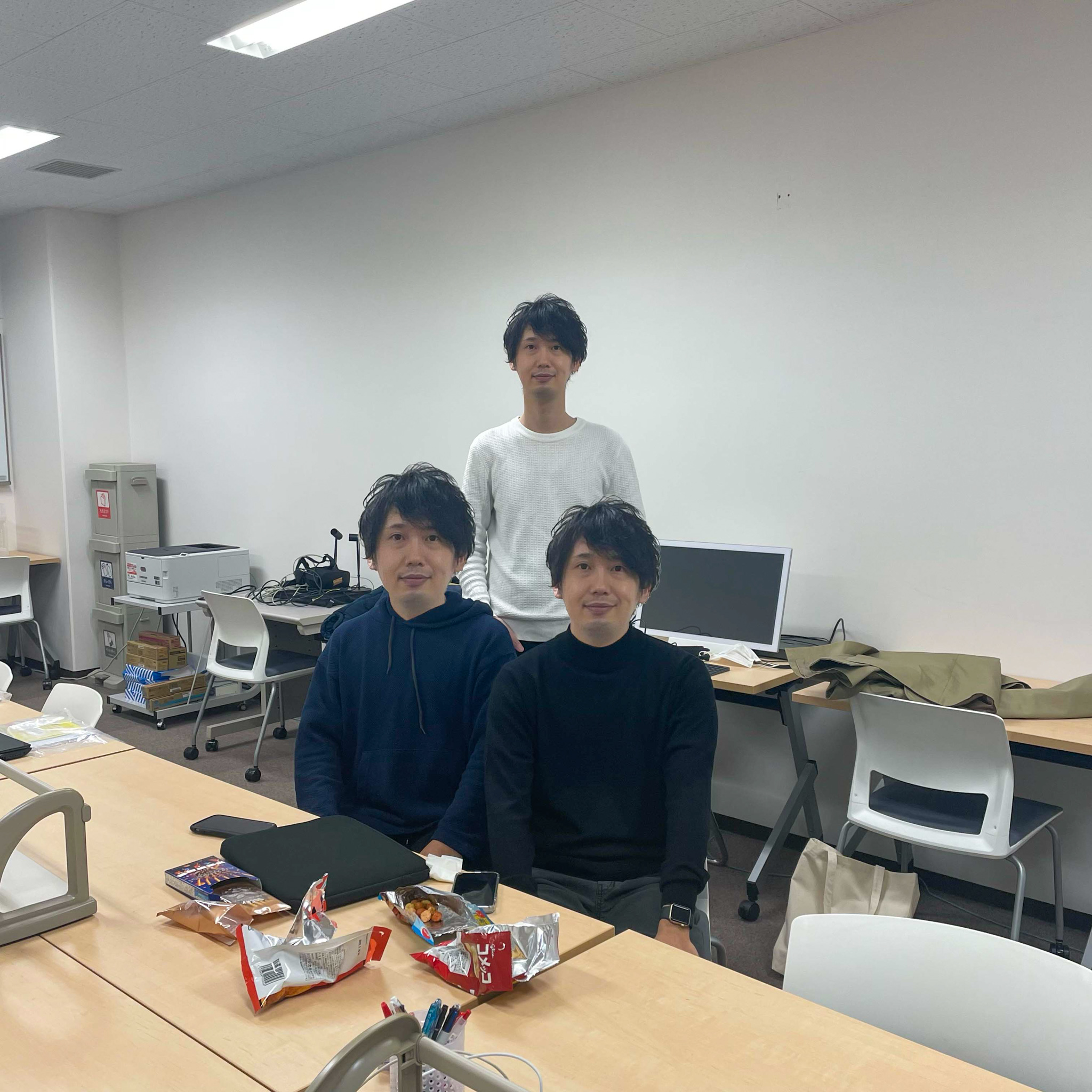
Temporal and spatial cognition
Humans do not perceive the world as it is. We primarily use illusions to study how humans perceive and recognize space (and the objects within it) (e.g., Ono, Yamada, Takahashi, Sasaki, & Ariga, 2023). For example, we investigate how objects are recognized, using the illusion that objects appearing in the same place are perceived as having the same identities (spatial congruency bias) (Sasaki, Ariga, & Watanabe, 2020).
Illusions related to time also exist. Do you not find that 10 minutes spent talking with a friend feels fleeting, while 10 minutes spent in a queue feels extremely long? Beyond such common everyday examples, temporal illusions can also be induced by visual information. We study how manipulating various visual features (such as texture and motion) alters temporal illusions (Sasaki & Yamada, 2017; Sasaki, Yamamoto, & Miura, 2013; Sasaki, Taya, & Miura, 2014; Yamada, Sasaki, & Miura, 2014; Yamamoto, Sasaki, & Watanabe, 2016) to uncover the mechanisms underlying temporal cognition.
Moreover, there exists a unique linkage between space and time. For instance, the past is associated with the left side, and the future with the right side (mental timeline). Our lab investigates how the mental timeline manifests in human behavior (e.g., Uchikawa, Miura, & Sasaki, 2024). As an example, we are examining whether the mental timeline influences the expression and interpretation of paintings (Nishigaki, Nakamura, Miura, Yamada, & Sasaki, 2024).
Nishigaki, Y., Nakamura, K., Miura, K., Yamada, Y., & Sasaki, K. (2024). Is the spatial position of the sun utilized for time-of-day perception and expression in paintings? 33rd International Congress of Psychology, Prague, Czech Republic.
Ono, F., Yamada, Y., Takahashi, K., Sasaki, K., & Ariga, A. (2023). Backward illusory line motion: Visual motion perception can be influenced by retrospective stimulation. Journal of Vision, 23(6):6, 1-11.
Sasaki, K., Ariga, A., & Watanabe, K. (2020). Spatial congruency bias in identifying objects is triggered by retinal position congruence: Examination using the Ternus-Pikler illusion. Scientific Reports, 10: 4630
Sasaki, K., Taya, S., & Miura, K. (2014). Numbers increasing to the right contract perceived time. International Journal of Affective Engineering, 13, 279-284.
Sasaki, K., & Yamada, Y. (2017). Regular is longer. i-Perception, 8, 1-7.
Sasaki, K., Yamamoto, K., & Miura, K. (2013). The difference in speed sequence influences perceived duration. Perception, 42, 198-207.
Uchikawa, N., Miura, K., & Sasaki, K. (2024). Past on the left side and future on the right side: Examination of mental timeline by using a word allocation task. 33rd International Congress of Psychology, Prague, Czech Republic.
Yamada, Y., Sasaki, K., & Miura, K. (2014). Time-to-contact estimation modulated by implied friction. Perception, 43, 223-225.
Yamamoto, K., Sasaki, K., & Watanabe, K. (2016). The number-time interaction depends on relative magnitude in the suprasecond range. Cognitive Processing, 17, 59-65.

Mental metaphor
In our mind, sensorimotor experiences are linked to abstract concepts. The mental timeline (i.e., the association between space and time) is one example of this. Additionally, there is also the relationship between emotional valences and space: Positive and negative valences are intertwined with the upper /dominant sides and the lower/non-dominant sides, respectively (space-valence metaphor). Our lab investigates how the space-valence metaphor manifests in our behavior and explores its mechanisms (Sasaki, Seno, Yamada, & Miura, 2012; Sasaki, Yamada, & Miura, 2015, 2016). Furthermore, through replication studies and research involving minority groups, we examine the robustness and generalizability of the space-valence metaphor (Sasaki, Yonemitsu, Yamada, 2019; Yonemitsu, Sasaki, & Yamada, 2023; Zhu, Sasaki, Jiang, Qian, & Yamada, in prep). Recently, we have also confirmed the existence of the spatial-emotional metaphor in artificial intelligence (ChatGPT-4) (Sasaki, Yonemitsu, & Yamada, 2024).
Sasaki, K., Seno, T., Yamada, Y., & Miura, K. (2012). Emotional sounds influence vertical vection. Perception, 41, 875-877.
Sasaki, K., Yamada, Y., & Miura, K. (2015). Post-determined emotion: motor action retrospectively modulates emotional valence of visual images. Proceedings of the Royal Society B: Biological Sciences, 282: 20140690.
Sasaki, K., Yamada, Y., & Miura, K. (2016). Emotion biases voluntary vertical action only with visible cues. Acta Psychologica, 163, 97-106.
Sasaki, K., Yonemitsu, F., & Yamada, Y. (submitted).
Yonemitsu, F., Sasaki, K., & Yamada, Y. (2023). The superiority of up/down over left/right in metaphorical association with emotion. The Japanese Journal of Psychonomic Science, 42, 11-18. (*equal contribution)
Zhu, S., Sasaki, K., Jiang, Y., Qian, K., & Yamada, Y. (in prep).

Impressions of Human-like Robots and CGI
You might feel an eerie discomfort when encountering realistic human CGI or robots (herein referred to as human-like agents). This feeling is commonly associated with the uncanny valley phenomenon. Our lab conducts foundational research to unravel the mechanisms behind the uncanny valley. Specifically, we explore this from the perspectives of visual categorization difficulties (Is it a human? A robot? Which one?) and stranger avoidance (It’s better to avoid unknown objects) (Kawabe, Sasaki, Ihaya, & Yamada, 2017; Sasaki, Ihaya, & Yamada, 2017). We are also applying this framework to impressions of food and perceptions of people wearing masks (Tachibana, Ozaki, Hashimoto, & Sasaki, in press; Yamada, Sasaki, Kunieda, & Wada, 2014).
With advances in technology, the uncanny valley may likely be resolved. Indeed, improvements in CGI technology are already producing characters that closely resemble real humans and do not evoke eeriness. However, does this mean that feeling eeriness towards human-like agents will disappear in the future? Anticipating a future where identically appearing human-like agents might be mass-produced, we have studied the impressions formed when people encounter a gathering of agents with the same face (envision Agent Smith in The Matrix). Our findings reveal that such situations are perceived as eerie (clone devaluation effect), and we have further investigated the underlying mechanisms (Yonemitsu, Sasaki, Gobara, & Yamada, 2021a, b).
Kawabe, T., Sasaki, K., Ihaya, K., & Yamada, Y. (2017). When categorization-based stranger avoidance explains the uncanny valley: A comment on MacDorman and Chattopadhyay (2016). Cognition, 161, 129-131.
Sasaki, K., Ihaya, K., & Yamada, Y. (2017). Avoidance of novelty contributes to the uncanny valley. Frontiers in Psychology, 8:1792.
Tachibana, T., Ozaki, T., Hashimoto, K., & Sasaki, K. (in press). Affective reactions evoked by masks with an implied mouth. Perception.
Yonemitsu, F., Sasaki, K., Gobara, A., & Yamada, Y. (2021). The clone devaluation effect: Does duplication of local facial features matter? BMC Research Notes, 14: 400.
Yonemitsu, F., Sasaki, K., Gobara, A., & Yamada, Y. (2021). The clone devaluation effect: A new uncanny phenomenon concerning facial identity. PLOS ONE, 16: e0254396.

Trypophobia
The lotus seed pod evokes an indescribable sense of discomfort. This is known as trypophobia (e.g., Sasaki & Yamada, 2018). Incidentally, this photo is indeed of a lotus seed pod, but I have intentionally blurred it (as many people are uncomfortable with it!). If you are curious, feel free to search for “trypophobia” (but be warned, it can be unsettling).
In our lab, we are studying how trypophobia occurs. For example, we have identified that some visual features (e.g., spatial frequency) of clustered objects is one of the key factors contributing to this discomfort (Sasaki, Yamada, Kuroki, & Miura, 2017). Additionally, we have hypothesized that trypophobia may be an overgeneralization of the avoidance response to infectious skin diseases, and we have conducted preliminary surveys to support this hypothesis (Yamada & Sasaki, 2017). Recently, we have been interested in “who is more or less susceptible to trypophobia,” and as part of this, we have conducted studies involving minority groups in China (Zhu, Sasaki, Jiang, Qian, & Yamada, 2020) and young children (Imura, Suzuki, Kasahara, Sasaki, Yamada, & Shirai, 2024; Suzuki, Shirai, Sasaki, Yamada, & Imura, 2023).
Imura, T., Suzuki, C., Kasahara, M., Sasaki, K., Yamada, Y., & Shirai, N. (2024). Effects of cluster size on trypophobic discomfort in children aged 4–9 years. Scientific Reports, 14: 16528Sasaki, K., Yamada, Y., Kuroki, D., & Miura, K. (2017). Trypophobic discomfort is spatial-frequency dependent. Advances in Cognitive Psychology, 13, 224-231.(*equal contribution)
Suzuki, C., Shirai, N., Sasaki, K., Yamada, Y., & Imura, T. (2023). Preschool children aged 4 to 5 years show discomfort with trypophobic images. Scientific Reports, 13:2768.
Yamada, Y., & Sasaki, K. (2017). Involuntary protection against dermatosis: A preliminary observation on trypophobia. BMC Research Notes, 10:658.
Zhu, S., Sasaki, K., Jiang, Y., Qian, K., & Yamada, Y. (2020). Trypophobia as an urbanized emotion: Comparative research in ethnic minority regions of China. PeerJ, 8:e8837.

Self-awareness
How do humans distinguish between themselves and others, and how do they recognize the concept of “self”? Our research focuses on the consciousness of self, specifically looking at the “body” and the “actions” performed through it. The feeling that one is performing an action themselves (i.e., the sense of agency) has been shown to be retrospectively influenced by the quantity of the results of the action (Yasuda & Sasaki, 2024). Furthermore, we have clarified that this sense of agency is crucial for developing the sense of body ownership (Hidaka, Sasaki, Kawagoe, Asai, & Teramoto, 2021). Additionally, personal possessions are often perceived as extensions of the self. Our lab is also studying the sense of ownership over objects (the feeling that “this is mine!”) and the relationship between possessions and the self (Guo, Ikeda, Takashima, Masuda, Ueda, Ariga, Sasaki, & Yamada, 2023; Iseki, Sasaki, & Kitagami, 2022; Sasaki, Watanabe, & Yamada, 2025).
Guo, W., Ikeda, A., Takashima, K., Masuda, Y., Ueda, K., Ariga, A., Sasaki, K., & Yamada, Y. (2023). Social distancing between personal belongings during the COVID-19 pandemic. F1000Research, 12(199), 199.
Hidaka, S., Sasaki, K., Kawagoe, T., Asai, N., & Teramoto, W. (2021). Bodily ownership and agency sensations in a natural state. Scientific Reports, 11: 8651.
Iseki, S., Sasaki, K., & Kitagami, S. (2022). Development of a Japanese version of the Psychological Ownership Scale. PeerJ, 10:e13063.
Sasaki, K., Watanabe, K., & Yamada, Y. (2025). Sense of object ownership changes with sense of agency. Journal of Experimental Psychology: Human Perception and Performance, 51, 50–69.
Yasuda, R., & Sasaki, K. (2024). Sense of agency based on the numerical magnitude of action-outcomes. PsyArXiv. https://doi.org/10.31234/osf.io/bmz3y
Bridging Basic and Applied Research
Basic psychological and cognitive science research has provided fascinating insights into human behavior. There are often situations where the social applications of these findings are anticipated. In this case, the robustness and generalizability of these findings are crucial for their application in society. Our laboratory explores the applicability of basic psychological and cognitive science research by examining the robustness and generalizability of these findings. To date, we have not been able to replicate the phenomena reported in the original studies we have addressed (Kohama, Yasuda, Iwasa, & Sasaki, 2024; Sasaki, Kobayashi, Nakamura, & Watanabe, 2023; Yang, Wu, Sasaki, & Yamada, 2020, 2021; Yonemitsu, Ikeda, Yoshimura, Takashima, Mori, Sasaki, Qian, & Yamada, 2020), which makes us hesitant to confidently assert their robustness or generalizability.
On the other hand, we collaborate with information scientists on various research projects. Specifically, we assist in evaluating the effectiveness of developed systems and devices. Currently, we are involved in research on the effectiveness of a picture book search system (Ōtake, Okumura, Gōbara, Naka, Yonemitsu, Sasaki, Watanabe, Fujita, Hattori, Yamada, & Kobayashi, 2017), a robotic device for infant care training (Tsuji, Yamamoto, Yamaji, Kobayashi, Sasaki, Aso, & Sugiura, 2024), and a clinical reasoning support system for novice physical therapists (Yoshida, Hatakeyama, Sugimoto, Hori, Sasaki, Takaoka, & Matsushita, 2023).
Kohama, H., Yasuda, R., Iwasa, M., & Sasaki, K. (2024). Package impressions based on product categories and locations of a product image. 33rd International Congress of Psychology, Prague, Czech Republic.
Sasaki, K., Kobayashi, M., Nakamura, K., & Watanabe, K. (2023). The evasive truth: Do mere exposures at the subliminal and supraliminal levels drive the illusory truth effect? Royal Society Open Science, Royal Society Open Science, 10: 201791 (*equal contribution)
Tsuji, H., Yamamoto, T., Yamaji, S., Kobayashi, M., Sasaki, K., Aso, N., & Sugiura, Y. (2024). Smartphone-Based Teaching System for Neonate Soothing Motions. 2024 IEEE/SICE International Symposium on System Integration (SII), 178-183.
Yang, J., Wu, X., Sasaki, K., & Yamada, Y. (2020). Changing attitudes to health compliance through repetition of persuasive messages in the COVID-19 pandemic. PeerJ, 8:e10318.
Yang, J., Wu, X., Sasaki, K., & Yamada, Y. (2021). No significant association of repeated messages with changes in health compliance in the COVID-19 pandemic: A registered report on the extended parallel process model. PeerJ, 9:e11559.
Yonemitsu, F., Ikeda, A., Yoshimura, N., Takashima, K., Mori, Y., Sasaki, K., Qian, K., & Yamada, Y. (2020). Warning ‘Don’t spread’ vs. ‘Don’t be a spreader’ to prevent the COVID-19 pandemic. Royal Society Open Science, 7: 200793